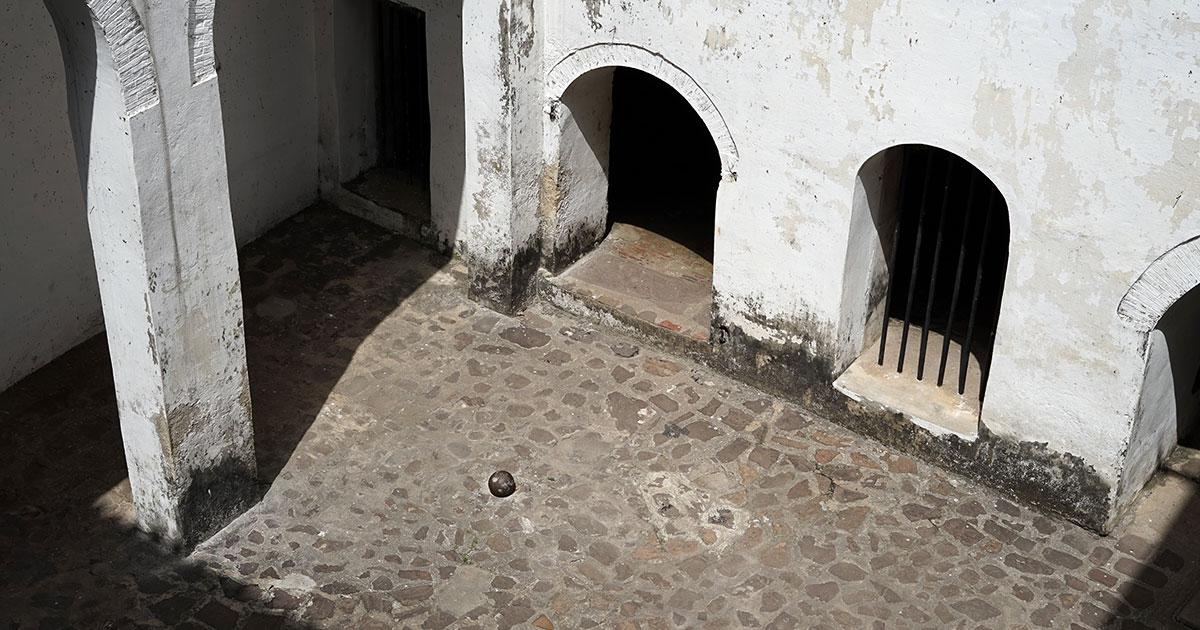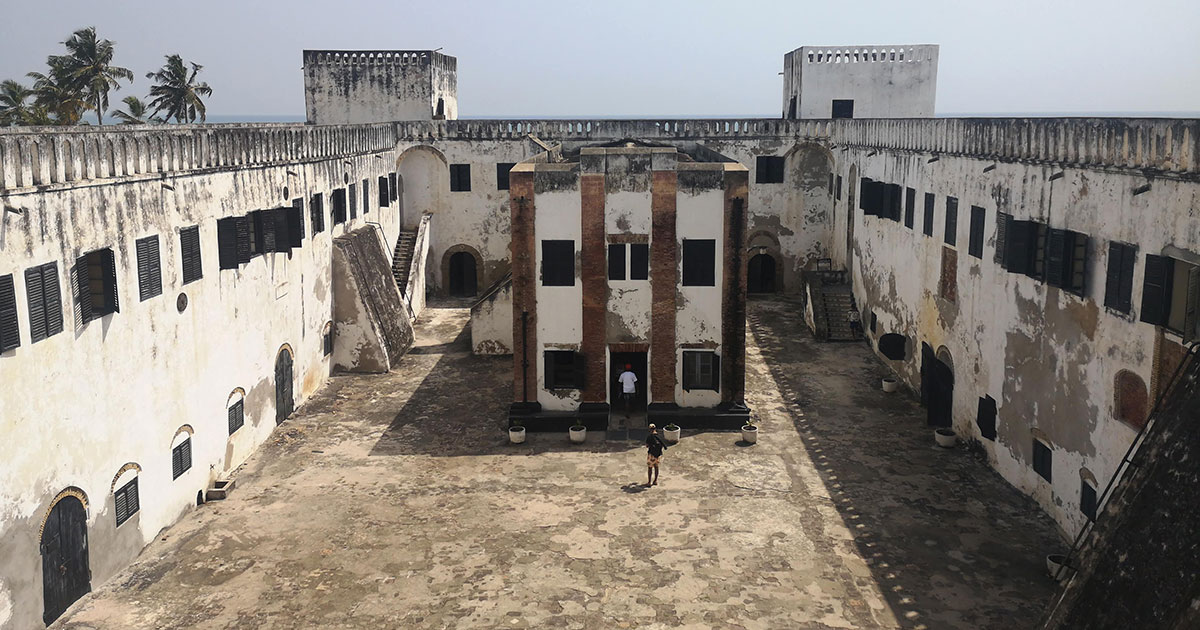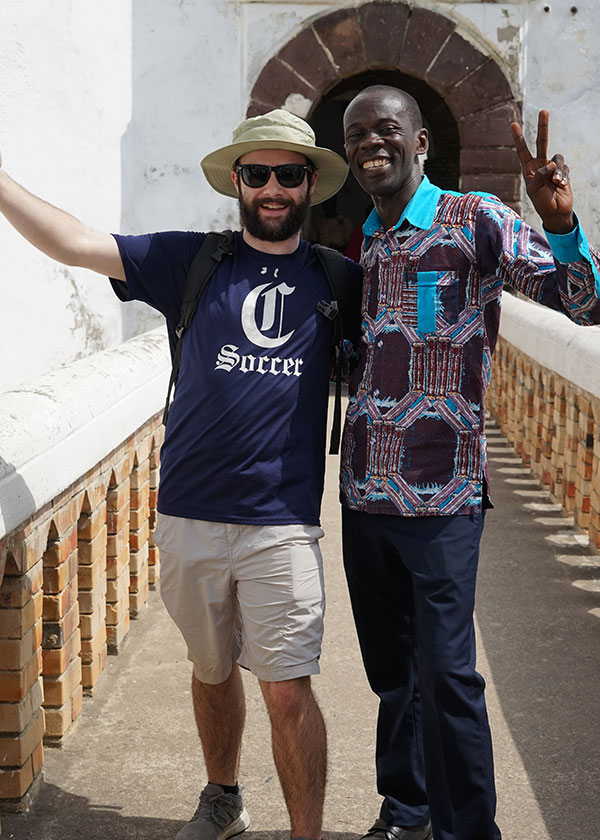Ian Greeley: Student Report from 2019 Alternative Winter Break to Ghana
One of my most memorable moments on the trip to Ghana occurred while visiting one of the European coastal castles built during the colonial period in Ghana. We toured the two best preserved forts on the Ghanaian coast, the Elmina Castle and the Cape Coast Castle. Both are located in the Central Province, near the city of Cape Coast where our group stayed for the duration of our trip. The two castles were originally erected as trading posts by the Portuguese, before being used heavily on the transatlantic slave trade as they changed hands between various European colonial empires. Now, the Ghanaian castles are listed on the UNESCO World Heritage List and serve as painful but valuable reminders of a dark part of our history.
The first of the castles we visited was the Elmina Castle, the larger of the two. At this location, captives were confined in horrendous conditions – chained by their feet in dungeons with little light, food, or water, slaves were only allowed buckets as toilets, but many could not even reach them due to their chains. Slaves were branded when they were sold and transported through the Door of No Return to ships that would take them to their destination. The levels above the dungeons were spacious quarters for the castle garrison; rather ironically, places of worship for the colonial soldiers could be found directly above slave dungeons at both locations. One of the worst parts of the site was near the Governor’s balcony overlooking the dungeons. Stairs from the women’s dungeon led straight to the Governor’s quarters, through which a selected slave could be taken from the dungeon for the Governor to rape. If the chosen woman resisted, she would be chained to a cannon ball in the center of the courtyard and forced to attempt to carry it despite her starved, dehydrated, and weakened state, often until her death. To demonstrate the awkwardness and difficulty of such a task for even an unrestrained and well-fed individual, our guide encouraged some of us to try to pick up the cannon ball. This sparked a few laughs from our group as some of us attempted to lift it.

After the castle tour, our group was ambushed by a woman from another tour group, who, upset from seeing what she viewed as disrespectful behavior on our part (potentially the incident with the cannon ball), verbally assaulted us on the path back to our bus. While I initially did not believe that our group acted improperly at the castle, it was evident that at least one person thought we did. Her response to our perceived misdoings was excessive and bigoted in nature, but, upon reflection, may not have been completely unwarranted. I don’t believe that the cannon ball incident was disrespectful, in fact, it was encouraged by our guide. The person who later confronted us may have either seen only a portion of the incident or misinterpreted what she saw, but it shows that even a well-meaning visitor can be interpreted as inconsiderate. Regardless, an encounter like that should prompt some reflection on how to act abroad (as representatives of our country) and at memorials or historical sites marking events like genocide, violent repression, or acts of terrorism.
The general advice I’ve seen online for how to act at memorial sites is mostly intuitive if you approach the situation with solemnity. Acting respectfully can include keeping your voice low, not running in the area, refraining from outside activities (remember Pokemon GO?), abstaining from smoking or drinking alcohol, and keeping pets away. At many locations, you can touch certain memorials, but you are often asked to refrain from placing things like drinks on them. Many memorials ask guests to not eat at the location and to especially avoid acts like littering. If offered, guided tours of locations are likely better than self-led tours to get into the appropriate mindset while visiting the site. One piece of advice seen very commonly online pertains to pictures. Most memorials and historical sites (outside of museums) allow for photos, but thought should be given as to the reason that pictures are being taken – the photos should be about the site. Selfies and pictures of yourself are not necessarily disrespectful, but pictures should be taken to reinforce the importance of the history of the site and retell the stories of those affected.
Keeping this in mind, the picture that I took in front of the castle entrance with one of our local guides could easily be viewed as taken in bad taste – similar pictures would have been more suitable at some of the more light-hearted locations we visited during the trip. The picture may, in fact, prompt light comparison to the photos used by satirist Shahak Shapira in his project “Yolocaust,” a website from 2017 that pulled flippant selfies and pictures of tourists at the Berlin Holocaust memorial from social media and replaced the background of the memorial with scenes from concentration camps. The website was intended to illustrate the dissociation with taking cheerful and out-of-place pictures in a somber setting like the memorial. The architect who designed the Berlin memorial, Peter Eisenmen, disapproved of Shapira’s site and rejected the idea that the monument should instill a feeling of guilt, but rather suggested it should help us get over the guilt and learn from the experiences of the past. As he points out, the memorial isn’t a burial ground, and there are no remains under the site, so his plan for the location was for people of different ages to deal with being in that place in their own way. The same is not said for the concentration camps, nor the Ghanaian castles we visited – many slaves died on the grounds and were buried in mass graves during the potentially three months wait for a ship to arrive to carry them across the Atlantic. The unruliest captives were even locked in dedicated chambers and only taken out once they were dead. Although the history of the locations warrants more consideration of one’s conduct than a normal memorial would necessitate, we should still remember that Eisenmen’s notion of guilt should still apply to visitors of the castles.
Sites like the castles are not only for descendants of slaves and those most affected by the slave trade, but also for groups like ours from UT as a preventative lesson and an influence on our moral sense in present times. Precisely because our nation was built on the backs of the slaves funneled out of ports like the Elmina and Cape Coast Castles is why we should be visiting the locations, so they can remind us, “Never Again,” as one of our tour guides declared. Sites like these should encourage our advocacy for action against forms of modern slavery, such as forced labor, sexual exploitation, and forced marriage; although it is difficult to pinpoint an accurate number, institutions like the United Nations and International Labor Organization estimate between 20 to 40 million people are currently trapped in some form of slavery.
As a final aside, the castles themselves could certainly do a better job of reminding people of the purpose for which they came to the location. Courtyard areas of both castles were converted into shops for selling local wares, and our tour guide at the Elmina Castle even paused mid-way through the tour and encouraged us to take a few minutes to browse the shops that had been set up in the upper portions of the building near the Governor’s quarters. While such practice surely helps fund the renovation and maintenance of the historical site, the shops also contribute to tourists’ abstraction when visiting the castles.


